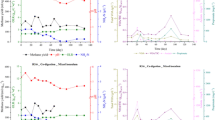Abstract
Recycling of plant materials and agricultural residues for biomethanation was attempted in vials. The methanogenic activities of certain sewage samples have also been tested. Both sterilized and non-sterilized biomasses were used. Biomethanation was carried out with dung samples (cow, goat, buffalo, piggery wastes and poultry wash) as wild populations of microbes and in combination with other microbial isolates (isolated in the laboratory).
Biomethanation had been observed to be good in most cases and particularly with the sterilized biomass. Mixed inoculum (dung samples and poultry wash) was found to be best for biomethanation. Of the microbe isolates, isolates from buffalo, pig and paper mill wastes appear to be most effective. Pretreated sawdust and rice straw were found to be good subtrates for biomethanation. Of the different plant biomass used Spirogyra (algae), Ipomea and water hyacinth were most effective whereas Jatropa gossypifolia and Parthenium sp. were the least effective. Biomethanation of Spirogyra was carried out both in anoxic and oxic conditions. Though methane production decreased enormously under oxic conditions, definite methane production continued indicating that the biomethanation process is not exclusively anoxic. Similarly, biomethanation of sewage samples from different sewage treatment plants were carried out with and without isolated methanogens and methane production was found to be moderate.
Similar content being viewed by others
References
Bachman, J.S., Petitdemange, E. and Prost C. (1984) Influence of an Enriched Inoculum with Selected Anaerobic Bacteria(cellulolytic or methanogenic) on the Methane Fermentation of Cellulosic Material by a Wild Microbial Population in Anaerobic Digestion and Carbohydrate Hydrolysis of Waste, pp. 235–44. London and New York: Elsevier Applied Science Publishers.
Chakravorty, N., Sarkar, G.M. and Lahiri, S.C. (1996) Competitive biomethanation using substrates in combination and by cross inoculation. The Environmentalist 16, 111–15.
Chakraborty, N., Sarkar, G.M. and Lahiri, S.C. (2000a) Cellulose degrading capabilities of cellulolyticbacteria isolated from the intestinal fluids of the silver cricket. The Environmentalist 20, 9–11.
Chakraborty, N., Sarkar, G.M. and Lahiri, S.C. (2000b) Methane emission from rice paddy soils, aerotolerance of methanogens and global thermal warming. The Environmentalist 20(4), 343–50.
Demuynck, M. and Nyns, E. (1984) Biogas plants in Europe. J. International Solar Energy 2(6), 477–85.
Ferrero, G.L., Ferranti, M.P. and Naveau, H. (ed.) (1984) Anaerobic Digestion and Carbohydrate Hydrolysis of Waste, p.517.London and New York: Elsevier Applied Science Publishers.
Fetzer, S., Bak, F. and Cornad, R. (1993) Sensitivity of methanogenic bacteriafrom paddy soil to oxygen and desiccation. FEMS Microbiology Ecology 12, 107–15.
Gerritse, J.and Gottschal, C.J.(1993) Two-membered mixed cultures of methanogenic and aerobic bacteria in O2-limited chemostats. J. General Microbiology 139, 1853–60.
Hobson, P.N. (1984) Production of biogas from agricultural wastes.In Advance in Agricultural Microbiology (N.S. Subba Rao, ed.) pp.523–48. New Delhi: Oxford and IBH Publishing Co.
Humphries, E.C. (1956) Mineral components and ash analysis. In ModernMethods of Plant Analysis (K. Paech and M.V. Tracey, eds.) vol.1; pp. 468–502. Berlin, Gottingen-Heidelberg: Springer Verlag.
Kasali, G.B. (1990) Solid-state refuse methanogenic fermentation: Control and promotion by water addition. Letters in Applied Microbiology 11(1), 22–6.
Klass, D.L. and Ghosh, S. (1980) Methane production by anaerobic digestion of water hyacynth (Eichhornia crassipes).Prep. Rap. Am. Chem. Soc. Div. Fuel Chem. 25(4), 221–32
Lahiri, S.C. (1999) Biogas generation: Some salient features. Proc.Renewable Energy Congress, Kalyani University, India, pp. 28–45.
Palz, W., Chartier, P. and Hall D.O. (eds.) (1982) Energyfrom Biomass (1st European Communities Conference) p. 982. London and New York: Applied Science Publishers.
Ranade, D.R., Meher, K.K. and Gadre, R.V. (1991) Microbial pretreatment of biomass for biogas production. Biovigyanam 17, 61–5.
Ranade, D.R., Yeole, T.Y. and Godbole, S.H. (1987) Production of biogas from market wastes. Biomass 13, 147–53.
Strub, A., Chartier, P.and Schlesser, G.(1983) Energy from Biomass (2nd European Communities Conference) p. 1148. London and New York: Applied Science Publishers.
Van Buren, A. (ed.) (1979) A Chinese Biogas Manual, Popularizing Technology in the Country Side(M.Cook, Translator) pp. 1–135. London: Intermediate Technology Publication Ltd.
Van der Vlugat, A.J. and Rulkens, W.H. (1984)Biogas production from a domestic waste fraction. In Anaerobic Digestion and Carbohydrate Hydrolysis of Waste, pp. 245–50. London and New York: Elsevier Applied Science Publishers.
Vimal, O.P. and Tyagi, P.D. (1984) Energy from Biomass, Part 2, pp. 213–336.New Delhi: Agricole Publishing Academy.
Wimpenny, J.W.T. and Abdollahi, H. (1991) Growth of mixed cultures of Puracoccusdenitrificans and Desulfovibrio desulfuricans in homogeneous and heterogeneous culture systems. Microbial Ecology 22, 1–13.
Author information
Authors and Affiliations
Rights and permissions
About this article
Cite this article
Chakraborty, N., Sarkar, G. & Lahiri, S. Biomethanation of plant materials and agricultural residues using dung samples as wild population of microbes and also with isolated methanogens. The Environmentalist 22, 173–182 (2002). https://doi.org/10.1023/A:1015346119325
Issue Date:
DOI: https://doi.org/10.1023/A:1015346119325




